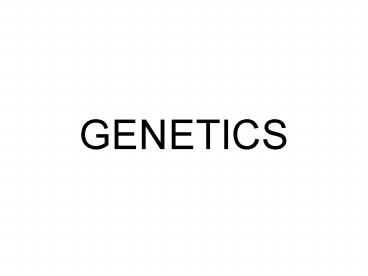GENETICS - PowerPoint PPT Presentation
1 / 77
Title: GENETICS
1
- GENETICS
2
Central Dogma
- DNA transcribedgt RNA translatedgt proteins
3
DNA structure
4
The building blocks of DNA Nucleotides
5
DNA Nucleotides include
- ADENINE base pairs with Thymine
- THYMINE base pairs with Adenine
- CYTOSINE base pairs with Guanine
- GUANINE base pairs with Cytosine
6
DNA replication
- The duplication of DNA double helix prior to cell
division - Semiconservative
7
DNA REPLICATION
8
TYPES OF RNA
- Messenger RNA
9
- Transfer RNA
10
- Ribosomal RNA
11
TRANSCRIPTION OVERVIEW
12
TRANSLATION OVERVIEW
13
POSTTRANSCRIPTIONAL PROCESSING
14
DS DNA VIRUSES
15
RETROVIRUSES
16
REGULATION LAC OPERON
17
MUTATIONS
- Mutations are heritable changes in DNA
- Types
- Beneficial
- Harmful (deleterious)
- Silent
- They can also be small (e.g., point) or large
(e.g., deletions)
18
- GENETIC EXCHANGE IN BACTERIA
19
CONJUGATION
20
TRANSFORMATION
21
TRANSDUCTION
22
PLASMIDS
23
- INFECTION
- AND
- DISEASE
24
TYPES OF DISEASES
- inherited or genetic
- congenital
- Degenerative
- due to nutritional deficiencies
- Endocrine
- Mental
- Immunological
- neoplastic (e.g,. cancer)
- iatrogenic (especially nosocomial)
- idiopathic (unknown cause).
25
Inherited or genetic
26
Congenital disease
27
Degenerative diseases
28
Nutritional deficiency
29
(No Transcript)
30
Mental
31
Immunological
- In severe combined immunodeficiency, a person's
ability to fight infections is severely impaired.
This condition has been dubbed "bubble boy
disease" and became widely known during the 1970s
with the case of David Vetter, who lived for 12
years sealed in a plastic, germfree environment.
32
Cancer
33
Iatrogenic (nosocomial)
34
Idiopathic
35
RELATIONSHIPS WITH MICROBES DEPEND ON
- Species of microbe
- Race
- Age
- Immune status
- Stress
- Nutrition
- Hygiene
- Etc.
36
Types of relationships
- Beneficial to both
- Beneficial to one, harmful to the other -
- Pathogens
- Opportunists
- One benefits the other is not affected 0
- Harmful to both --
37
- Seven challenges
38
- RESERVOIRS
- Humans are the only reservoirs for many microbes
(e.g., the organisms that cause pertussis,
measles, colds, etc.). Some people appear to be
healthy but they carry the microbes (carrier). - Other microbes are maintained in non-human animal
reservoirs (zoonosis). - Finally some microbes are maintained in
non-living environments (the soil for
Clostridium).
39
- NEW HOST
- Direct Contact can be between an infected person
and a new host (person to person) or non-human
animal to human, or from the environment
(non-communicable infectious disease). - Some pathogens are spread by the fecal-oral route
that can be direct or indirect. - Indirect modes of transmission are inanimate
vehicles including fomites (an object that
harbors pathogens because it is subject to
constant contamination). - Airborne transmission.
40
ADHERENCE TO CELLS
41
- INVASION OF DEEPER TISSUES
42
- EVASION OF HOSTS DEFENSES
43
- Multiplication or reproduction. This stage often
results in the symptoms or damage (Table 19.1).
For example, some microbes destroy cells.
44
- Exiting the host
- The anatomical route is the portal of exit.
45
Types and Courses of infectious disease include
- Acute diseases - rapid onset and rapidly run
their course - Chronic diseases - relative slow onset and last
longer - Subacute diseases - intermediate
- Local infections - confined to specific areas
- Systemic infections spread throughout the body.
- Subclinical or inapparent infections symptoms are
slight - Septicemia - bacteria are present in and
multiplying in the blood - Bacteremia occurs when bacteria are transported
in the blood. - Primary infection is the initial infection and
can be followed by a secondary infection.
46
Stages
- 1. Incubation period
- 2. Illness
- 3. Convalescence
- 4. Latent period
- 5. Recurrence
47
Epidemiology
- the study of disease distributions in
populations and of the factors that influence
these distributions
48
- DEFENSES AGAINST DISEASE
49
OVERVIEW
- NON-SPECIFIC (INSIDE BODY IS SELF)
- 1ST LINE OF DEFENSE
- NON-SPECIFIC (SELF VS. NON-SELF)
- 2ND LINE OF DEFENSE
- SPECIFIC
- 3RD LINE OF DEFENSE
50
- FIRST LINE OF DEFENSE
- Skin, mucus membranes, their products
51
MECHICAL FACTORS INCLUDE
- 1. The closely packed cells and keratin of the
epidermis (fig. 15.1) - 2. The thick mucus produced by the cells of the
mucous membranes - 3. The lacrimal apparatus of the eye
52
CHEMICAL FACTORS INCLUDE
- 1. sweat is high in salt and that inhibits many
organisms. - 2. Lysozyme degrades peptidoglycan and is found
in tears, saliva, mucus, phagocytic cells, blood,
and interstitial fluid. - 3. Peroxidase in saliva, milk, body tissues, and
phagocytes breaks down H2O2. - 4. Lactoferrin bind iron and is found in saliva,
mucus, milk, and some phagocytes - 5. Defensins are thought to disrupt the
integrity of the cell and are found in mucus
membranes and phagocytes.
53
- SECOND LINE OF DEFENSE
54
PHAGOCYTOSIS
55
inflammation
56
Complement
57
Interferons
58
Lymphatic system
59
Apoptosis
60
- THIRD LINE OF DEFENSE
61
- TYPES OF IMMUNITY
62
Acquired immunity
63
MHC
64
Two types of specific immunity
- Antibody-mediated or humoral immunity
- Involves B cells (a type of lymphocyte)
- Cell-mediated immunity
- Involves T cells (another type of lymphocyte)
65
Components of Humoral immunity
- Virgin B cells
- Plasma cells (those that produce antibodies)
- Memory cells
- Antibodies (aka Immunoglobulins)
66
Structure of a typical antibody
67
Types of Antibodies
68
Cell-mediated immunity components
- Various types of T cells
69
SPECIFIC IMMUNITY
- http//science.nhmccd.edu/biol/inflam.swf
70
Antibody-mediated
71
Macrophage/processed Antigen/T helper complex
72
Clonal selection
73
Relationship between two types of specific
immunity
74
Cell-mediated immunity
75
Primary and Secondary immunity
76
Vaccinations
- Cell-free
- Live attenuated
- Killed, whole cell
77
Immunopathologies
- Too much of an immune response
- E.g., allergic reactions, autoimmune diseases
- Too little of an immune response
- E.g., AIDS, DeGeorge syndrome, Severe
- Combined Immunodefiency































